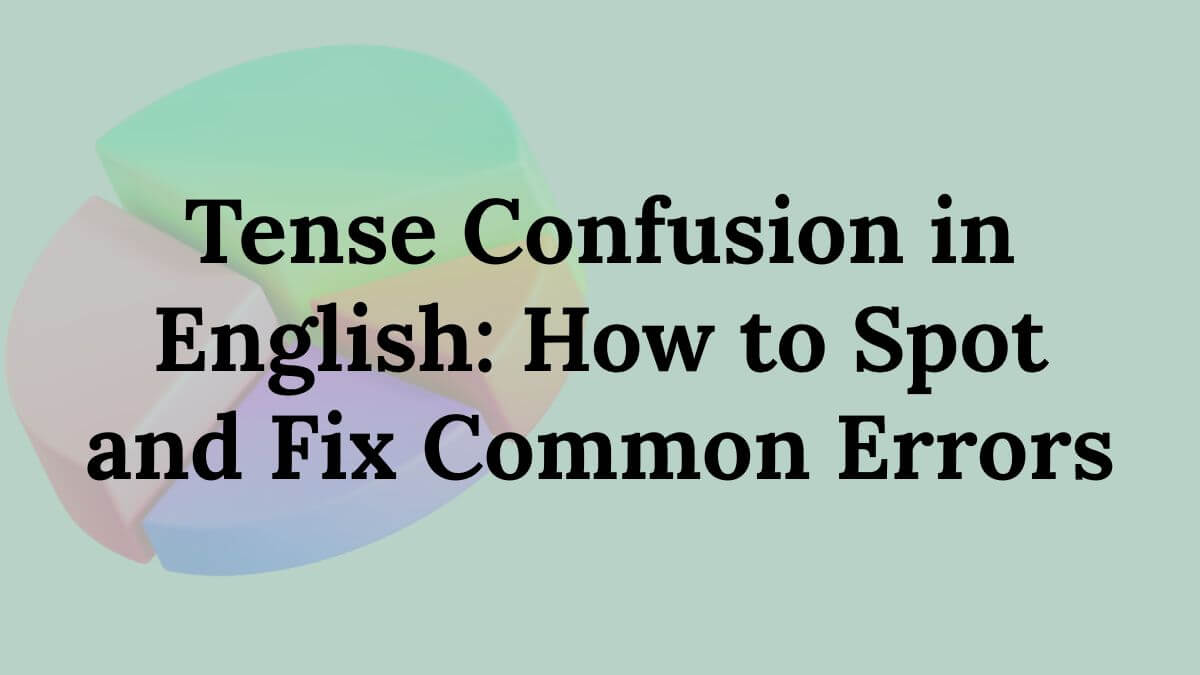Have you ever found yourself writing something and thinking, ‘Did I use the correct tense?’ If so, you’re not alone. Tense confusion in English is a widespread grammar challenge for both English learners and native speakers alike. Whether you’re writing an email, an essay, or speaking in daily conversation, choosing the correct tense is crucial for clear communication. In this guide, we’ll explore the most frequent tense errors, why they happen, and how to fix them—so you can boost your writing and speaking skills with confidence.
What Is Tense Confusion in English?
Tense confusion in English refers to the improper use of verb tenses in a sentence or paragraph. It often involves mixing present, past, and future tenses in a way that makes the meaning unclear or grammatically incorrect.
Proper usage: She put in a lot of effort and cleared the exam.
Incorrect Example: She studied hard and passed the exam.
These errors may seem small, but they can significantly affect how your message is understood.
Why Does Tense Confusion Happen?
- Thinking in Your Native Language
When learners translate directly from their native language, tense consistency can get lost. Not all languages use tenses the same way English does.
- Lack of Understanding of Tense Rules
English has 12 verb tenses. Without a strong grasp of how and when to use each one, it’s easy to mix them up.
- Switching Tenses Unintentionally
When writing or speaking, some people unintentionally shift from one tense to another—especially in longer sentences or storytelling.
Most Common Tense Confusion Errors
- Mixing Past and Present Tense
Many people make this common mistake when they write or talk.
Incorrect: I ate breakfast and went to school.
Accurate sentence: I ate my breakfast and later went to school.
When describing events that happened in the past, both verbs should be in the past tense.
- Using Present Perfect Incorrectly
The present perfect is often misunderstood and mistaken for the simple past by learners.
Incorrect: I have seen him yesterday.
Correct: I saw him yesterday.
The present perfect is not used with specific time references like yesterday, last year, or in 2020.
- Confusing Future Tenses
Many learners often feel unsure about when to use “will,” “going to,” or the present continuous tense.
I will go to the party. (decision made at the moment)
I am going to go to the party. (planned action)
I am going to the party. (definite arrangement)
Understanding the fine details makes it easier to avoid tense confusion in English.
- Inconsistent Tense in Paragraphs
Even if each sentence is correct, changing tenses unnecessarily can confuse readers.
Poor Style: She walks into the room, looked around, and smiles.
Improved: She walked into the room, looked around, and smiled.
Maintain tense consistency unless there’s a good reason to vary it.
Read More:
A Simple Guide to the Parts of Speech with Examples
7 Common Mistakes with Auxiliary and Modal Verbs – And How to Fix Them!
How to Spot Tense Confusion in English
- Check Time Indicators
Words like yesterday, tomorrow, now, last year, and soon can guide the tense you need.
- Look at the Main Verb
Does the verb accurately show when the action happened? Cross-check it with other verbs in the same sentence or paragraph.
- Read Aloud
Often, tense confusion in English becomes more noticeable when you listen to the flow of the sentence. When something sounds off, there’s a good chance it’s wrong.
Tips to Avoid Tense Confusion
- Learn the 12 English Tenses
Familiarize yourself with:
- Present Simple
- Present Continuous
- Present Perfect
- Present Perfect Continuous
- Past Simple
- Past Continuous
- Past Perfect
- Past Perfect Continuous
- Future Simple
- Future Continuous
- Future Perfect
- Future Perfect Continuous
A basic understanding of each will drastically reduce errors.
- Use Consistent Time Frames
Pick a time reference for your narrative and stay consistent with it.
- Use Grammar Tools
Grammar checkers like Grammarly or the Hemingway Editor can catch some tense inconsistencies. But understanding the rules yourself is the best long-term solution.
- Practice with Real Sentences
Write short paragraphs and highlight the verbs. Check whether they all align in tense and meaning.
Practice Makes Perfect: Examples
Paragraph with Tense Confusion:
I woke up early yesterday and went for a run. Then I ate breakfast and was reading the newspaper.
Corrected Version:
I woke up early yesterday and went for a run. Then I ate breakfast and read the newspaper.
You can tell that all verbs align with the past tense now.
Tense Confusion in English in Spoken Language
People make tense errors not just when writing but also when talking. In casual settings, people may not notice, but in interviews or academic speech, it matters.
Tip: Practice common scenarios like introducing yourself, telling a story, or describing future plans—using correct tenses.
Final Thoughts: Overcoming Tense Confusion in English
Tense confusion in English may seem overwhelming at first, but it’s completely manageable with consistent practice and awareness. By learning the key rules, identifying your weak spots, and using helpful tools, you’ll become more confident and accurate in both writing and speaking.
Key Takeaways:
- Determine the timing of the event before choosing your verb tense.
- Keep your tenses consistent in sentences and paragraphs.
- Practice regularly to reinforce correct usage.
With strong tense skills, you can clearly communicate across time—just like controlling language-based time travel. Let tense confusion in English no longer stand in your way. With patience and persistence, you’ll speak and write like a pro!
